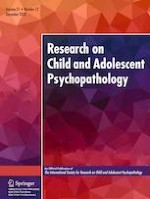04-03-2023
Role of Developmental Timing of Childhood Adversity in Nonsuicidal Self-Injury Persistence or Desistance
Gepubliceerd in: Research on Child and Adolescent Psychopathology | Uitgave 12/2023
Log in om toegang te krijgenAbstract
Given the high prevalence of nonsuicidal self-injury (NSSI), scientific interest is on the rise, yet its developmental course remains understudied. Factors that may influence NSSI behavior are also unclear, although early research describes it as a maladaptive form of emotion regulation. In a college student sample (N = 507), the current study examines the extent that developmental timing of, and cumulative exposure to, potentially traumatic events (PTEs) accounts for variance in NSSI frequency, duration, and desistance, as well as the role that emotion regulation difficulties (ERD) play. Of 507 participants, 411 endorsed PTE exposure and were categorized into developmental groups based on age of initial PTE exposure, with the hypothesis that initial exposure during early childhood and adolescence may represent particularly sensitive risk periods. Results revealed that cumulative PTE exposure was significantly positively associated with shorter NSSI desistance, whereas ERD were significantly negatively associated with shorter NSSI desistance. However, the interaction between cumulative PTE exposure, when coupled with current ERD significantly moderated (i.e., strengthened) the path between cumulative PTE exposure and NSSI desistance. When examined individually, this interaction was only significant for the early childhood group, suggesting that the effects of PTE exposure on NSSI persistence may vary not only as a function of emotion regulation capacities but also when in the developmental course initial PTE exposure occurs. These findings contribute to our understanding of the role of PTE and timing, as well as ERD, in predicting NSSI behavior, and can inform programs and policies to prevent and curtail self-harm.
